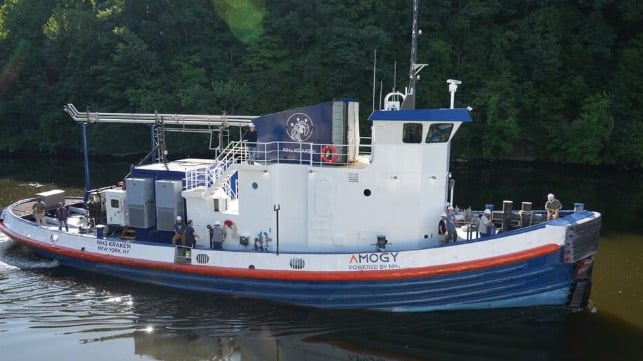With Korean Support, Amogy Takes Ammonia Propulsion Tech Ashore

One of South Korea's policy banks has made a significant investment in clean power company Amogy, which is designing a system to run hydrogen fuel cells with an ammonia fuel source.
Ammonia is one of the most promising available fuel options for low-emission propulsion, but it generally requires a small amount of carbon-based fuel to initiate combustion. Burning ammonia also produces NOx, which must be abated before the exhaust stream is released to the atmosphere.
Amogy's technology takes a different route. Instead of an internal combustion engine as the primary energy generating device on board, it substitutes hydrogen fuel cells. Since these can't run on straight ammonia, Amogy has developed compact equipment that can break down ammonia into its constitutent elements - nitrogen and hydrogen. The nitrogen gas gets released back to the atmosphere, while the hydrogen goes into the fuel cell to generate power. There is no combustion involved, so there are no onboard emissions. (Lifecycle emissions still depend upon the source of the ammonia, whether from green energy or from natural gas.)
Amogy is still a few years out from developing a system large enough for a merchant ship, but it has a test-scale platform on a tugboat and is working on a terrestrial powerplant version as well. It has been successful in raising funds to support its R&D process, and its latest round came to $23 million - led by a tech-focused arm of Korea Development Bank (KDB), the policy bank that supports South Korea's major shipyards and shipowners. The funds will be used to "drive market entry in Asia and scale stationary power applications alongside maritime innovation," Amogy said.
Korea has a well-developed interest in green propulsion technology, which it hopes to leverage as a competitive edge in a tough shipbuilding market. But clean ammonia for ships could just as easily be used on shore, where it is just as needed for decarbonization objectives. Amogy noted that Korea's Clean Hydrogen Portfolio Standard (CHPS) and Distributed Energy Act (DEA) will lift the use of hydrogen and ammonia, and that these two closely-related feedstocks will supply two percent of the country’s electricity by 2030 and seven percent by 2035.
"We’ve long recognized the strong demand for ammonia-to-power technology in the shipping industry, but we also see much broader opportunities to use ammonia as a clean fuel – especially with the growing demand for the ‘clean power’ globally. We’re ready to meet that market demand," said Seonghoon Woo, co-founder and CEO at Amogy. “Support for a hydrogen-based economy is especially strong in Asia, and as the most cost-effective hydrogen carrier, ammonia is quickly evolving into the leading zero-carbon fuel solution for these markets."
